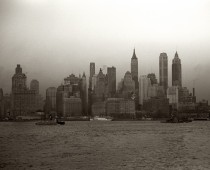Creators
Rachel Wittmann, Boni Joi Koelliker, Mary Seem, Erin Noto
Deemed “the most ideal way of getting about in the world” the Third Avenue El was both
loved and loathed during its 77-year existence. Built in 14 months and opened in 1878, the elevated public transit trains that ran up and down Third Avenue were a treat for the
eyes but a pain for the ears. Stations were ornate; wood-lined waiting rooms featured
intricate ironwork, gingerbread moldings, stained glass windows, and were topped with
gable roofs, similar to the chalet-style buildings of one of the original draftsman’s native
Switzerland. The ride itself provided an unparalleled view of the city. Yet the train ran
close to homes and businesses and the constant noise and pollution from the trains was
part of the impetus for the closing of the elevated lines. It was easy to see why residents
would like to see an end to the El: it was “rusty and screeching [and] seen as producing
little but blight.”
The train’s proximity allowed for an intimate view into the lives of Manhattanites, with tracks less than 30 feet from apartment windows in some sections. It was this glimpse that fueled the long-standing admiration and nostalgia for the El. Part of this nostalgia can been felt in E.B. White’s Here is New York, written in 1949 when the Third Avenue El was the last-standing of Manhattan’s elevated trains. White wrote: “The elevated railways have been pulled down, all but the Third Avenue. An old-timer walking up Sixth past the Jefferson Market jail misses the railroad, misses its sound, its spotted shade, its little aerial stations, and the tremor of the thing” When the Third Avenue El made its last journey from Chatham Square to 149th Street on May 12, 1955, it began its ride into history as an iconic image of New York’s past.
Bibliography and credits
Davidson, C. (Producer). (n.d). Third avenue El. [Audio from video]. Retrieved from: http://archive.org/details/ThirdAve1950
Moore, F. (1996, January 14). The El’s distant rumble. The New York Times Magazine.
New York Transit Museum. (1914, May 11). New Bowery. [Photograph].
New York Transit Museum. (1914, November 5). LKG N on 3 Ave from N of 166 St. [Photograph].
New York Transit Museum. (1915, January 28). 156th St sta. temporary walls and roof bracing. [Photograph].
New York Transit Museum. (1915, February 20). Span 387 LKG North. [Photograph].
New York Transit Museum. (1915, June 12). Claremont Parkway sta. 3rd Ave North from bent 396. [Photograph].
New York Transit Museum. (1931, March 5). No title: ceiling with decorative ironwork. [Photograph].
New York Transit Museum. (1931, March 5). No title: station platform and ceiling. [Photograph].
New York Transit Museum. (1931, March 5). No title: pillar with decorative ironwork at top. [Photograph].
New York Transit Museum. (1951, February 6). Camera facing N/E showing col. 33 E. and entrance to Ransan Restaurant @ Pearl and Coenties slip. [Photograph].
Nycsubway.org. (n.d.). Image 116122. [Photograph]. Retrieved from: http://www.nycsubway.org
Nycsubway.org. (1914, December 23). Image 116284. [Photograph]. Retrieved from: http://www.nycsubway.org
Nycsubway.org. (1939) IRT route map (small) (1939.). [Map]. Retrieved from: http://www.nycsubway.org
Nycsubway.org: Ed Watson and Arthur Lonto Collection. (1940s). Image 27803. [Photograph]. Retrieved from: http://www.nycsubway.org
Nycsubway.org: Frank, J. (Photographer). (1957). Image 26019. [Photograph]. Retrieved from: http://www.nycsubway.org
Nycsubway.org: Pfuhler, F. (Photographer). (1957). Image 75723. [Photograph]. Retrieved from: http://www.nycsubway.org
Nycsubway.org: Pfuhler, F. (Photographer). (1957). Image 75726. [Photograph]. Retrieved from: http://www.nycsubway.org
Nycsubway.org: Pfuhler, F. (Photographer). (1957). Image 75732. [Photograph]. Retrieved from: http://www.nycsubway.org
Nycsubway.org: Pfuhler, F. (Photographer). (1957). Image 75740. [Photograph]. Retrieved from: http://www.nycsubway.org
Nycsubway.org: Palter, B. (Photographer). (n.d.). Image 57306. [Photograph]. Retrieved from: http://www.nycsubway.org
NYPL Digital Gallery: Abbott, B. (Photographer). (1936, April 24). ‘El’, Second and Third Avenue lines, Bowery and Division Sts., Manhattan. Image ID 482709. [Photograph]. Retrieved from: http://www.nycsubway.org
NYPL Digital Gallery: Abbott, B. (Photographer). (1936, April 24). ‘El’, Second and Third Avenue lines, Bowery taken from Division Sts., Manhattan. Image ID 482843. [Photograph]. Retrieved from: http://www.nycsubway.org
Sewell, C. (2005, May 1). The spell of the El. The New York Times.
Stetler, L. (1995). By the El: Third Avenue and its El at mid-Century. (11) Flushing, NY: H&M Productions.
Stratler, S. (2006) Farewell to the El: Nostalgic urban visuality on the third Avenue elevated train. American Quarterly. 58(3). 869-890. Retrieved from: http://www.jstor.org/
Talk of the town: Notes and comments. (1955, May 21). The New Yorker, pp. 27.
White, E.B. (1999) Here is New York. (48) New York, NY: The Little Bookroom. (Original work published in 1949).
Inspiration
P. 48 “The elevated railways have been pulled down, all but the Third Avenue. An old-timer walking up Sixth past the Jefferson Market jail misses the railroad, misses its sound, its spotted shade, its little aerial stations, and the tremor of the thing.”

Pingback: The Third Avenue El: Train on High | The Trove Rove.